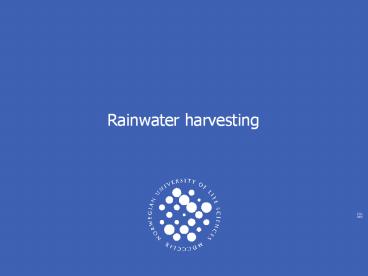Rainwater harvesting - PowerPoint PPT Presentation
Title: Rainwater harvesting
1
Rainwater harvesting
2
Total World Water Supply
Location Water Volume (km3) of Total Water
Oceans 1,230,000,000 97.17
Ice caps and glaciers 28,600,000 2.5
Atmosphere 12,700 0.001
Rivers and Streams 1,200 0.0001
Lakes (Fresh water) 123,000 0.009
Groundwater (Shallow to depth of 0.8 km) 4,000,000 0.31
- Over 70 of our Earth's surface is covered by
water - More than 97 of Earths water is in the oceans,
2 is in ice and glaciers- (Both are unsuitable
for human use because of Salinity (Ocean Water)
and location (ice caps and glaciers) - The total amount of water for which all the
people, plants and animals on Earth compete is
much less than 1 of the total
3
The Water Cycle
1- Precipitation 2- Infiltration- contributes
Ground water sources 3- Transpiration 4- Surface
runoff contributes to surface water sources 5-
Evaporation 6 - Condensation
4
Rainwater harvesting- Alternative water source
- Technology used for collecting and storing
rainwater for human use from rooftops, land
surfaces - Decentralised system Installed in houses,
Institutions, community
5
Where rainwater harvesting is particularly
attractive ?
- Rural area with no surface water sources
- Supply from surface and groundwater sources
cannot meet the water demand (Urban area) - Groundwater contaminated with Arsenic
- Household do not have capacity to pay for
centralised water supply system
6
Benefit of Rainwater harvesting
- Has multiple uses-
- Domestic consumption
- toilet flushing, sprinkling,
- ground water recharge,
- reduces urban storm runoff and associate flooding
and errosion - Low maintenance
7
Component of Rainwater harvesting
8
Typical Domestic Rainwater Harvesting System
Source http//www.eng.warwick.ac.uk/DTU/rainwater
harvesting/index.html
9
Ground Catchment System
10
Ground Catchment System
11
Typical Domestic Rainwater Harvesting System
Source http//www.eng.warwick.ac.uk/DTU/rainwater
harvesting/index.html
12
Conveyance
- Gutters and Downspouts
- Gutters are installed to capture rainwater
running off the eaves of a building.
Semi-circular gutters of PVC material
13
Storage
- Storage tank, acts to flatten out any fluctuation
in rainfall and usage allowing water use to be,
to a greater or lesser extent, independent of
rainfall. - Types
- Ferrocement tank - cement-rich mortar reinforced
with layers of wire mesh, - Fiberglass
14
Storage Tanks
PVC
Concrete tanks
15
Sizing of storage tank
- Demand side approach
- A very simple method is to calculate the largest
storage requirement based on the consumption
rates and occupancy of the building. - Consumption per capita per day, C 20 litres
- Number of people per household, n 6
- Longest average dry period 25 days
- Storage requirement C x n x 25 3000 litres
16
Quality of rainwater
- The quality of rainwater is relatively good but
it is not free from all impurities. - Depends upont type and condition of the
catchments and the storage tank - Dust from the soil, and droppings of birds and
animals could be the source of contamination by
the bacteria.
17
Method to enhance quality
- The first run off from the roof should be
discarded to prevent entry of impurities from the
roof. - In case of difficulties in the rejection of
first flow- - Clean the roof and gutter at the beginning of
the rainy season
18
Method to enhance quality
- Cleanliness of roof and storage tank is critical
in maintaining good quality of rainwater. - The storage tank requires cleaning and
disinfection when the tank is empty or at least
once in a year.
19
Leaf Eater/Leaf Beater/Leaf Catcha
Source http//www.rainharvesting.com.au
20
Disinfecting Rainwater
- Rainwater can be used for drinking, if it is
clear, has no or very little taste or smell and
is from well maintained system - Rainwater may not meet WHO drinking water quality
standards, specifically microbiological quality
standards, hence some disinfection is
recommended. - Disinfection can be done by
- boiling the water in before consumption
- adding chlorine compounds/bleaching powder in
required quantity to the water stored in the
tank. - using slow sand filtration
- solar disinfection (SODIS)
21
Rainwater Harvesting from Domed Stadium in Japan
Source Zaizen et al. (1999)
22
Bibliography
? Rainwater Harvesting and Utilization. An
Environmentally Sound Approach for Sustainable
Urban Water Management An Introductory Guide
for Decision-Makers. IETC-UNEP, Japan. ?
Rainwater catchment systems for Household Water
Supply (1991). Environmental Sanitation Reviews
No No 32. ENSIC, Bangkok, Thailand. ?
UNEP-IETC (1999) Proceedings of the
International Symposium on Efficient Water Use
in Urban Areas - Innovative Ways of Finding
Water for Cities. (8 to 10 June 1999), Kobe,
Japan. ? Gould, J. and Nissen-Petersen, E.
(1999) Rainwater Catchment Systems for Domestic
Supply. IT Publications, London ? Hasse, R.
(1989) Rainwater Reservoirs- Above Ground
Structures for Roof Catchment. GTZ. ? NGO
Forum and SDC (2001) Rain Water Harvesting
System. NGO Forum for Drinking Water Supply and
Sanitation and SDC, Bangladesh.
23
Web Resources on RWH (1)
? International Rainwater Catchment Systems
Association http//www.eng.warwick.ac.uk/ircsa/ ?
American Rainwater Catchment
Association http//www.arcsa-usa.org/ ? Centre
for Science and Environment (CSE),
India http//www.rainwaterharvesting.org ?
Development Technology Unit, School of
Engineering, University of Warwick, UK
http//www.eng.warwick.ac.uk/DTU/rwh/index.html ?
Chennai Metrowater, India
http//www.chennaimetrowater.com/rainwaterfaqs.ht
m ? Rainwater Partnership http//www.rainwaterpa
rtnership.org/
24
Web Resources on RWH (2)
? Lanka Rainwater Harvesting Forum http//www.ra
inwaterharvesting.com ? International Rainwater
Harvesting Alliance http//www.irha-h2o.org/ ? Gr
eater Horn of Africa Rainwater Partnership
(GHARP) http//www.gharainwater.org/ ? The Web
of Rain http//www.gdrc.org/uem/water/rainwater/r
ain-web.html

